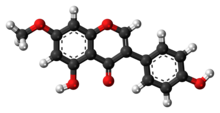
| |

| |
| Names | |
|---|---|
| IUPAC name
4′,5-Dihydroxy-7-methoxyisoflavone
| |
| Systematic IUPAC name
5-Hydroxy-3-(4-hydroxyphenyl)-7-methoxy-4H-1-benzopyran-4-one | |
| Other names
Prunusetin
5,4'-dihydroxy-7-methoxyisoflavone | |
| Identifiers | |
3D model (JSmol)
|
|
| ChEBI | |
| ChEMBL | |
| ChemSpider | |
| ECHA InfoCard | 100.008.199 |
| EC Number |
|
| KEGG | |
PubChem CID
|
|
| UNII | |
CompTox Dashboard (EPA)
|
|
| |
| |
| Properties | |
| C16H12O5 | |
| Molar mass | 284.26 g/mol |
Except where otherwise noted, data are given for materials in their standard state (at 25 °C [77 °F], 100 kPa).
| |
Prunetin is an O-methylated isoflavone, a type of flavonoid. It has been isolated for the first time by Finnemore in 1910 in the bark of Prunus emarginata (the Oregon cherry).[1] Prunetin isolated from pea roots can act as an attractant for Aphanomyces euteiches zoospores.[2] It is also an allosteric inhibitor of human liver aldehyde dehydrogenase.[3]
Prunetin can lower blood pressure of spontaneously hypertensive rats and relax isolated rat aortic rings through calcium channel block mechanisms in vessel smooth muscles.[4]